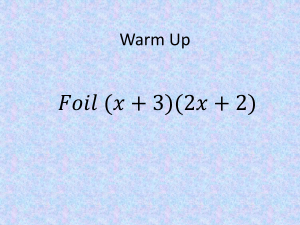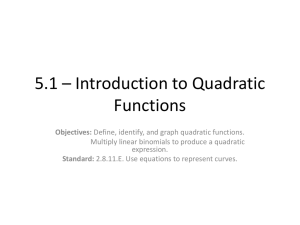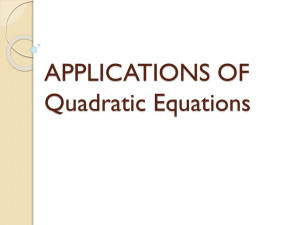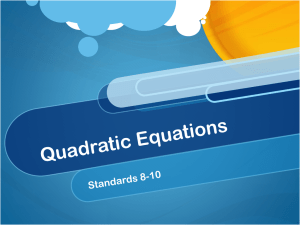Document
advertisement
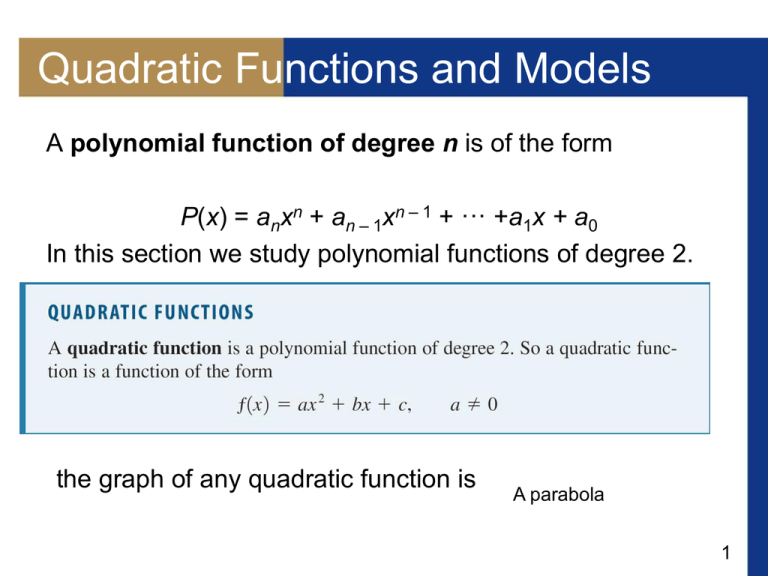
Quadratic Functions and Models A polynomial function of degree n is of the form P(x) = anxn + an – 1xn – 1 + ··· +a1x + a0 In this section we study polynomial functions of degree 2. A par the graph of any quadratic function is A parabola 1 Graphing Quadratic Functions Using the Standard Form 2 Example 1 – Standard Form of a Quadratic Function Let f(x) = 2x2 – 12x + 23. (a) Express f in standard form. (b) Sketch the graph of f. 3 Example 1(a) – Solution Since the coefficient of x2 is not 1, we must factor this coefficient from the terms involving x before we complete the square. f(x) = 2x2 – 12x + 23 = 2(x2 – 6x) + 23 Factor 2 from the x-terms = 2(x2 – 6x + 9) + 23 – 2 9 Complete the square: Add 9 inside parentheses, Subtract 2 9 outside = 2(x – 3)2 + 5 Factor and simplify The standard form is f(x) = 2(x – 3)2 + 5. What info can we get from this form? 4 Example 1(b) – Solution cont’d We sketch the graph in Figure 1 after noting that the y-intercept is f(0) = 23. Figure 1 5 Maximum and Minimum Values of Quadratic Functions If a quadratic function has vertex (h, k), then the function has a minimum value at the vertex if its graph opens upward and a maximum value at the vertex if its graph opens downward. 6 Example 2 – Minimum Value of a Quadratic Function Consider the quadratic function f(x) = 5x2 – 30x + 49. (a) Express f in standard form. (b) Sketch the graph of f. (c) Find the minimum value of f. 7 Example 2 – Solution (a) To express this quadratic function in standard form, we complete the square. f(x) = 5x2 – 30x + 49 = 5(x2 – 6x) + 49 = 5(x2 – 6x + 9) + 49 – 5 9 = 5(x – 3)2 + 4 Factor 5 from the x-terms Complete the square: Add 9 inside parentheses, subtract 5 9 outside Factor and simplify 8 Example 2 – Solution cont’d (b) The graph is a parabola that has its vertex at (3, 4) and opens upward, as sketched in Figure 2. Figure 2 (c) Since the coefficient of x2 is positive, f has a minimum value. The minimum value is f(3) = 4. 9 Example 3 – Maximum Value of a Quadratic Function Consider the quadratic function f(x) = –x2 + x + 2. (a) Express f in standard form. (b) Sketch the graph of f. (c) Find the maximum value of f. 10 Example 3 – Solution (a) To express this quadratic function in standard form, we complete the square. y = – x2 + x + 2 = –(x2 – x) + 2 Factor –1 from the x-terms Complete the square: Add inside parentheses, subtract outside Factor and simplify 11 Example 3 – Solution cont’d (b) From the standard form we see that the graph is a parabola that opens downward and has vertex As an aid to sketching the graph, we find the intercepts. The y-intercept is f(0) = 2. To find the x-intercepts, we set f(x) = 0 and factor the resulting equation. –x2 + x + 2 = 0 x2 – x – 2 = 0 Set y = 0 Multiply by –1 12 Example 3 – Solution (x – 2)(x + 1) = 0 cont’d Factor Thus the x-intercepts are x = 2 and x = –1. The graph of f is sketched in Figure 3. Graph of f(x) = – x2 + x + 2 Figure 3 13 Example 3 – Solution cont’d (c) Since the coefficient of x2 is negative, f has a maximum value, which is 14 Maximum and Minimum Values of Quadratic Functions in standard form with h = –b/(2a) and k = c – b2/(4a). Since the maximum or minimum value occurs at x = h, we have the following result. 15 Example 4 – Finding Maximum and Minimum Values of Quadratic Functions Find the maximum or minimum value of each quadratic function. (a) f(x) = x2 + 4x (b) g(x) = –2x2 + 4x – 5 16 Example 4 – Solution (a) This is a quadratic function with a = 1 and b = 4. Thus, the maximum or minimum value occurs at Since a > 0, the function has the minimum value f(–2) = (–2)2 + 4(–2) = –4 17 Example 4 – Solution cont’d (b) This is a quadratic function with a = –2 and b = 4. Thus, the maximum or minimum value occurs at Since a < 0, the function has the maximum value f(1) = –2(1)2 + 4(1) – 5 = –3 18 Example 5 – Maximum Gas Mileage for a Car Most cars get their best gas mileage when traveling at a relatively modest speed. The gas mileage M for a certain new car is modeled by the function M(s) = s2 + 3s – 31 15 s 70 where s is the speed in mi/h and M is measured in mi/gal. What is the car’s best gas mileage, and at what speed is it attained? 19 Example 5 – Solution The function M is a quadratic function with a = and b = 3. Thus, its maximum value occurs when The maximum is M(42) = (42)2 + 3(42) – 31 = 32. So the car’s best gas mileage is 32 mi/gal, when it is traveling at 42 mi/h. 20


